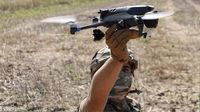On the night of November 12, 2025, the usually bustling Brussels Airport found itself at an unexpected standstill. Just after 11 p.m., air traffic was abruptly suspended following reports of drones flying over the airport, according to Philippe Touwaide, the federal mediator, and Belgian air navigation service provider skeyes. The pause in operations, though lasting only about half an hour, sent ripples across Europe’s already tense aviation landscape, underscoring the growing threat drones pose to critical infrastructure.
As skeyes explained, the decision to halt all flight operations was a precautionary measure, taken to ensure passenger and crew safety in the face of an unpredictable aerial intrusion. The Federal Ombudsman for Brussels Airport confirmed the incident on X (formerly Twitter), noting that the airspace was reopened around 23:20 local time. The impact was immediate: multiple inbound flights, including those from Dublin, Barcelona, Lisbon, Tenerife, Warsaw, Gran Canaria, and Toulouse, were forced to divert. For instance, a LOT Polish Airlines Embraer 190 arriving from Warsaw and a TUI fly Belgium Boeing 737 MAX 8 from Gran Canaria rerouted to Liège Airport, while a DHL Air Austria Boeing 757 from Toulouse was sent to Cologne. After the airspace reopened, the diverted passenger flights made their way back to Brussels, with LOT Polish Airlines touching down around 01:30 and TUI fly Belgium at approximately 00:30. Fortunately, no departing flights were scheduled after 22:00, which helped minimize the operational disruption.
This wasn’t an isolated event. Just days earlier, on November 4, both Brussels and Liège airports briefly halted services due to similar drone sightings, with Brussels Airlines forced to cancel 15 flights, as reported by Novyny.LIVE. The pattern is unmistakable: Europe is grappling with a surge in drone-related incidents that have disrupted airports and even threatened military facilities. Over the past few months, Copenhagen and Oslo airports were compelled to suspend operations for four and three hours respectively on September 22–23, 2025, rerouting flights and inconveniencing thousands. Munich Airport, too, found itself at the mercy of drone activity, shutting down twice on October 3 and 4, affecting over 6,500 passengers and leading to the cancellation of 17 flights.
The threat extends beyond civilian air travel. At Belgium’s Kleine-Brogel airbase—a site known for storing 10–15 US B61 nuclear bombs—drones were detected in what Belgian defense officials described as a likely reconnaissance attempt. The implications are sobering: drones, once seen as toys or tools for hobbyists, now represent a real and present danger to Europe’s security and daily life.
In response to this escalating crisis, Ukraine has stepped forward with a bold offer. On November 11, 2025, Ukraine proposed its anti-drone defense service, dubbed the "European Drone Wall," to the European Union. Anatolii Amelin, Deputy Head of the National Association of Defense Companies, outlined the concept in a column for Novyny.LIVE, presenting a vision of integrated, multi-layered protection against drone incursions.
“Instead of a magic button, what’s needed is a multi-layered architecture: passive radiofrequency analytics, optical confirmation, electronic countermeasures, kinetic interception, and—where appropriate—directed energy systems. All of this must operate under a unified C2 system with transparent protocols and clearly defined roles,” Amelin emphasized.
The European Drone Wall isn’t just a theoretical construct. It’s an integrated network designed to detect, classify, and neutralize drones along transport corridors and around critical infrastructure. At its core is the C-UAS (Counter-Unmanned Aircraft System) contour, seamlessly woven into the broader C4ISR (Command, Control, Communications, Computers, Intelligence, Surveillance, and Reconnaissance) architecture. For the EU, this means more than just technology; it calls for shared data standards, interoperable interfaces, and robust personnel training.
Why does Ukraine’s model stand out? For one, its anti-drone systems have been forged and proven under the extreme pressures of wartime. Facing drone swarms and relentless electronic jamming, Ukrainian defenses have demonstrated effectiveness and adaptability. Full defense contours can be deployed within weeks, with algorithms updated remotely to counter evolving threats. Unlike piecemeal solutions, Ukraine’s approach integrates sensors, optics, electronic warfare tools, kinetic and directed-energy weapons—all managed under a unified command-and-control structure with real-time analytics.
“Public data show that in 2024–2025, about $2.5 billion in state contracts were signed with 76 companies, expected 2025 export revenues at $10–30 billion, and a 350% sector growth since 2022—with around 60% localization and 97% of producers export-ready,” Amelin noted, highlighting the economic and industrial momentum behind Ukraine’s drone sector.
The scale is impressive. In 2024 alone, Ukraine produced over 1 million drones, with projections reaching up to 4.5 million in 2025. The wartime drone ecosystem has exploded from just 7 to over 500 companies, specializing in everything from electronic warfare to AI-driven autonomous control. In the first ten months of 2025, Ukraine recorded over 8,000 drone attacks and trained 40,000 drone operators. This ecosystem includes firms like Bullet, Degree-Trans, UkrJet, Terminal Autonomy, Tencore, Sine Engineering, and Vyriy—each contributing to a rapidly growing and export-focused industry.
Ukraine is also shifting from selling standalone anti-drone systems to offering “security-as-a-service.” This comprehensive model encompasses threat audits, sensor installation, electronic warfare integration, training, and ongoing operational support. The emphasis is on measurable results: detection times, interception probabilities, and false-alarm rates are all tracked and reported. Dozens of automated detection and suppression networks are already active near Kharkiv and in Ukraine’s southern regions, providing a real-world testbed for these advanced systems.
International partnerships are flourishing. Ukrspecsystems, for example, opened a plant in Mildenhall, UK, aiming to produce 2,000 drones per month with a $267 million investment. Ukrainian instructors are now training EU specialists, particularly after the spate of airport incidents in Denmark. Meanwhile, global players like DroneShield, Zen Technologies, Sentrycs, Allen Control Systems, and Rheinmetall have launched new programs and forged partnerships with Ukraine. Rheinmetall is set to deliver its first Skyranger 35 systems by late 2025, further strengthening Europe’s defensive posture.
Amelin has called for open pilot projects, public performance metrics, localized EU services, and joint training initiatives. He envisions deployment on four levels: national early warning systems and policy frameworks; regional personnel training and exercises; site-specific turnkey protection for airports, ports, and energy facilities; and operational support with continuous updates and incident response. This aligns closely with NATO’s Eastern Sentry initiative, which seeks to integrate C-UAS monitoring across the alliance’s eastern flank and paves the way for Ukrainian participation.
“When a client sees a predictable interception economy, unified protocols, and trained teams, the architecture becomes a standard—not just a one-time purchase. Ukraine is the architect of the European Drone Wall if we act now,” Amelin concluded.
As Europe faces a new era of aerial threats, the events at Brussels Airport serve as a wake-up call. The continent’s response—potentially anchored by Ukraine’s battle-tested expertise—may well define the future of security in the skies above.





